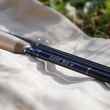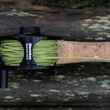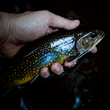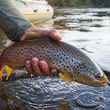Some time ago, I was introduced to several new products from an ambitious and innovative fly reel company from southwest Montana known as Bozeman Reel Company. Though Bozeman Reel Company has since expanded their offerings to include other fly fishing products and now goes by the moniker Bozeman Fly Fishing, their primary focus remains on their premium reels which are made entirely in Montana at their Bozeman headquarters. In early May I visited Bozeman Fly Fishing's headquarters to witness first-hand how their fly reels are made. Owner Dan Rice showed me around the machine shop, where we walked through the production process in detail from start-to-finish.
Attention to detail and high quality craftsmanship comes through in their production process – from the caliber of Montana-made materials they use in production to the careful inspection given throughout the entire process to ensure a consistent, superior finished product. And, as a fly reel company owned and operated by fly fisherman, Bozeman fly fishing knows very well how important a fly reel with a smooth, fish-stopping drag is to landing the big one.
Making a fly reel is complicated business. Each reel assembly is composed of 37 parts. According to Rice, eighteen of those, mainly major parts such as the spool, housing, drag knob, and handle, require some level of machining.

Bozeman Fly Fishing uses materials such as aluminum, Delrin, Rulon, and stainless steel in the production process. Some components are fashioned on a lathe. Others require more meticulous, varied operations on a CNC mill to ensure they have smooth, rounded edges.
"There is over two pounds of material that is carved away from the beginning material to arrive at the finished product," explains Rice.

Aluminum reel parts begin as bar stock. Smaller parts are turned on a lathe directly from the bar stock itself. Reel spools and housings begin as aluminum "pucks" cut from longer bar stock tubes, each weighing over a pound per piece at the start.
A lathe is used to accomplish the initial rotational cutting and boring. Then each puck is transferred to a CNC mill where a computer-aided design allows the machine to file and carve away excess material to form the more delicate, refined features most are familiar with on a finished reel.

Upon completion of the machining process, various finishing processes are implemented – tumbling, polishing, etc. – to ready the eighteen machined parts for assembly. Some parts are ready for assembly immediately following machining.
Nine of the finished components require anodizing, a process which uses increases thickness of the natural oxide layer on the surface of metal parts.

"This provides a longer-term defense against the elements and wear," says Rice.
Once machined and processed parts are ready, they are brought together in the assembly process to form a completed reel. While all production steps are critical, says Rice, if earlier steps are done correctly, the reel assembly process is fairly straightforward.

"We designed the reel to be easy to assemble, but not easy to disassemble," says Rice. "We don't want them falling apart during the heat of battle!"
During the assembly process, the drag unit, spindle and spindle cap assembly are carefully merged with the housing forming the core of the reel. The reel foot and clicker are also added at this time. The spool is a relatively simple addition of a counter weight, handle and spool nut.
"Once those are put together, we verify the fit and finish, put the drag know cap on (which tells us the size of the reel)," says Rice, "and then send it off for final inspection."

While he's never counted, Rice believes the reel production process may have well over 100 steps from start to finish. He hopes to eventually produce a "Value Stream Map" to help customers better understand Bozeman Fly Fishing's production process.
"With eighteen machined parts coming together to form something under five ounces, you need everything to fit correctly," says Rice. "That's why we are so diligent about in-process inspection and cataloging."

While Rice believes every step in the reel production process to be critical, he explains the most complicated parts will always be the spool and housing.
"They are the largest parts, have the most machining steps done to them and have the most complex inner workings to them by which everything else is built upon," he says. "It's very critical to have that as a great foundation."

To someone seeing the production process first hand, the level of pride Bozeman Reel Company takes in the tight tolerances they associate with their reels is evident. Their diligence, attention to detail and commitment to quality craftsmanship show in both their products and their employees.
For more info on Bozeman Fly Fishing, visit www.bozemanreel.com.
The particulars referenced in this piece pertain to Bozeman Fly Fishing's RS (River-Stream) series reels, the company's most popular reel.































Comments